Had to run for the train yet again. This time it was in the middle of nowhere and completely dehydrated because the sauna-like train I was on to Crimea sold only beer (seriously). Normally trains stop at bazaar-like stations, people selling fruit and bottled water to you through the windows. You’d think a 16-hour long train would have a few more provisions but, um, no. I asked the train attendant and she said the next stop would have water.
At the next stop, I got off and went to the station, stood in line at the cafe, and kept eye on the train. The line shrank slowly and I began to worry about get stranded. I was somewhere in the middle of Ukraine, but that’s all I could knew. I was in a tee-shirt, cotton shorts and sandals and that’s all I had. It was finally my turn but they had no water without gas. It’s a failing of mine in Ukraine, where gas water is the norm, but I can barely drink it. I turned to see the train moving. Good thing I didn’t buy water, because I now had to run.
I ran, in these foam sandals, leaping down onto one set of tracks (they are about five feet lower than the concrete), leaping up onto the concrete divide, back down onto another set of tracks, back up onto the next divide and finally down onto my tracks, running alongside the train, which was picking up speed. The door to my wagon was shut and the train was beginning to go faster. I was about to be stranded with nothing in the middle of nowhere (sort of: all my money and my passport was with me; I’m not that stupid). God dammit!
But someone must have seen me through a window because the door swung back open and I jumped on. The train attendant caught my arm and helped me. She shook her head with a wry smile. “American,” she said in Russian. The whole wagon knew who I was: I was traveling with Katie, and of course everyone heard our English. But when a girl came by who needed help with her bags, I started speaking to her in Russian. That caught people’s attention and since Ukrainians rarely hide their curiosity, I was mobbed by people most of the evening, six sitting around me at one point, asking questions about me and America and trying out the few English phrases they knew. The nice thing about answering the same questions for two years is that you get really good at giving thoughtful, grammatically perfect answers and everyone thinks your language is better than it is.
But I was out of breath when the attendant bemusedly said “American”, so all I could do was grin and say “Da.”
***
The first stop after spending an evening relaxing with my friend Mike in Simferopol was Bakhchysaray. Bakhchysaray is the main home of the Crimean Tartars, an ethnicity that had mostly fled the Soviet Union and its persecution but was now slowly returning to its homeland, starting with this city. My first encounter with this group was being cursed in the train station. I don’t know what I did (maybe I cut her off coming out the door) but suddenly an old woman was yelling at me, waving her hand in the air at me and repeatedly pointing at her palm. The tartars have their own language and I assumed it was this until I caught the words: “shestnatsit prostitutki”. Those words were Russian (or common to both languages), and I was surprised to hear them. It had occurred to me that she might simply have been forcefully blessing me, but as I turned and kept on walking, I could figure out how a curse or a bless could involve sixteen prostitutes.
Bakhchysaray, controlled for a long time by the Turks, was a treasure trove of sites. There were six of us there: five volunteers and Katie. Katie, myself and a volunteer named Patrick decided to brave the steep, mile-long path to see some of these sights. Chandani, Mona and Lauren decided to wait for us at a cafй. We trudged up first to see the Upsenky Monastery, a tiny church over 1,000 years old that had been carved into the limestone cliffs above Bakcherserai. In addition to a tiny worship area and some beautiful views, it also had a “healing fountain”. Unfortunately it wasn’t turned on.
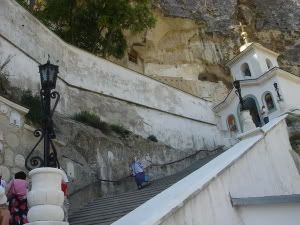
Upsenky Monastary
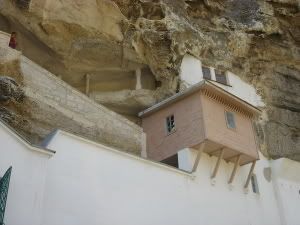
Another forty minutes of hiking brought us to Chufut-Kale, a cave city that constantly made me think of the Flintstones. Protecting Ukrainians, Turks, Tartars, Jews and their predecessors for more than 1,400 years, it is what it is: a lot of cool caves with windows and doors carved into them.
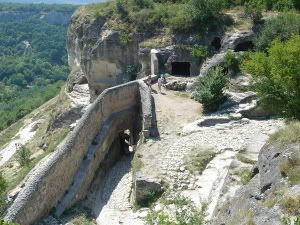
Living like the Flinstones
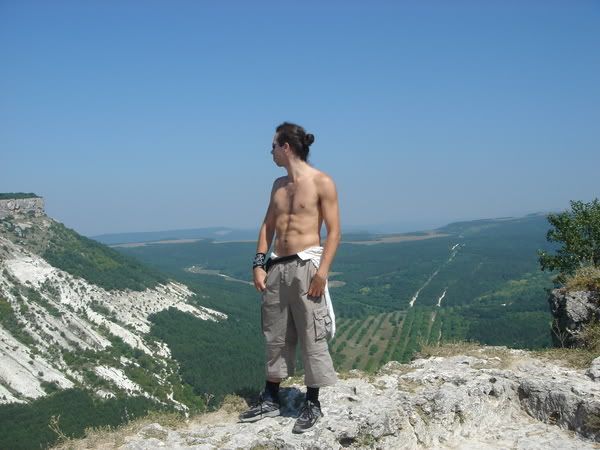
Yours truly on top of Chufut-Kale
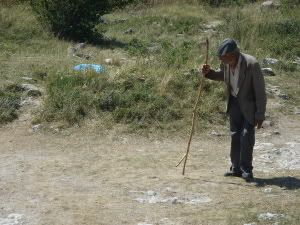
Interesting old guy

Tartar eating area
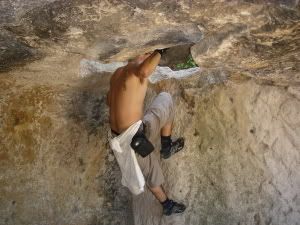
Climbing around in the caves
Meeting back up with the rest of the group, we headed down to the Khan’s palace. Although this and much of the rest of Crimea had been under Turkish control, most of that evidence had been wiped out under the rule of Catherine the Great of Russia. She spared the Khan’s palace, though, because of a poem. Pushkin had written about the “Fountain of Tears” which had been created to “contain the grief” of the last Crimean Khan. He had been so distraught over the death of one of his harem girls, a Polish beauty who never requited his love, that he was neglecting his country. The poem and the fountain were so famous in Russia that Catherine let the palace continue to exist.
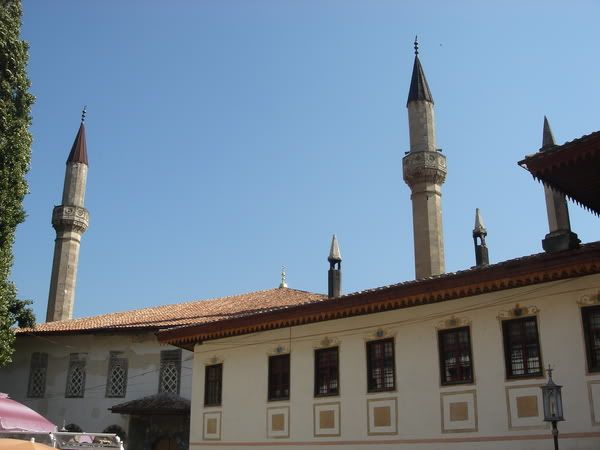
Minarets of the Khan's Palace
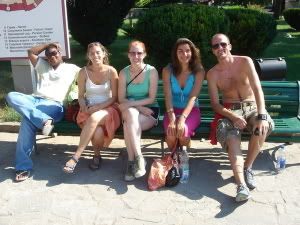
Chandani, Lauren, Mona, Katie and Patrick, relaxing at the Khan's Palace
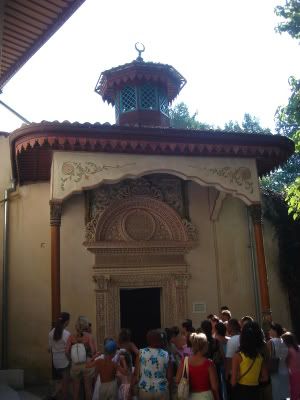
The Ambassador's gate at the palace
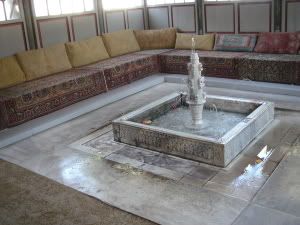
The Khan's swinging bachelor pad
After walking for an hour around through the beautiful rooms of the Palace, seeing the mosque, marveling at the minarets and really wishing I had a harem (the carpet-appointed room was only one of what used to be four harems in the palace), we still hadn’t found the fountain. Trying to demystify a map on one wall and unable to get my bearings (nor seeing a name for the Fountain of Tears), I stopped a tour guide, pointed at the biggest looking fountain on a map and asked how to get there. In a tone that said “you fucking idiot” was what lay beneath the words, the guide told me that the map was of how the palace had looked 300 years before and was no longer accurate. Oh. We finally found the fountain, had walked by it before because it was so tiny. But it did have the traditional roses laid atop it: one red for love, the other yellow for chagrin.
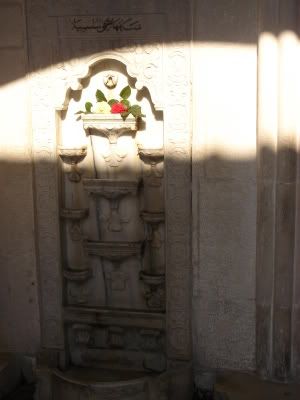
The Fountain of Tears
Getting back to the train station provided a political discourse: we had flagged down a car and the six of us piled in, me across the laps of the three girls in the back, Patrick sitting on Chandani’s lap in the passenger seat. This less than intelligent arrangement occurred because the driver had been yelling at us to get in as fast as possible. His name was Misha and he looked in his seventies. He charged us one hrivna each, much cheaper than the four we had been charged coming from the station. He asked in Russian where we were from. When told America he said, “horrible country.” I asked him why he thought that and he said how much better it had been under the Soviet Union and that the USA was responsible for its downfall. He stopped the conversation just long enough to ask Patrick, Patrick’s face pressed against the glass, if he saw a car coming. Patrick responded in a negative and Misha gunned onto the next street before picking up where he left of, saying how everything was cheap when he was growing up and everything was great until America had ruined it. But he seemed to have no problem giving a group of Americans a ride in his car and charging us much left than our last cab. He shook my hand when we got out and we caught the train back to Simferopal.